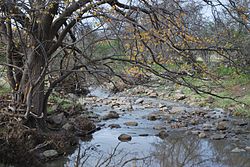| Little River[1] Worrin-yaloke | |
|---|---|
 Little River, near its source in Staughton Vale | |
| Native name | Diabagnorite (Wathawurrung) |
| Location | |
| Country | Australia |
| State | Victoria |
| Region | Victorian Midlands (IBRA), Greater Metropolitan Melbourne |
| LGA | City of Greater Geelong, City of Wyndham |
| Town | Little River |
| Physical characteristics | |
| Source | Brisbane Ranges |
| • location | Staughton Vale |
| • coordinates | 37°49′35″S 144°16′57″E / 37.82639°S 144.28250°E |
| • elevation | 176 m (577 ft) |
| Mouth | Port Phillip |
• location | north of Beacon Point |
• coordinates | 38°0′20″S 144°45′42″E / 38.00556°S 144.76167°E |
• elevation | 0 m (0 ft) |
| Length | 49 km (30 mi) |
| Basin features | |
| River system | Port Phillip & Westernport catchment |
| Tributaries | |
| • left | Balliang Creek |
| • right | Stony Creek (Greater Geelong), Reilly Creek |
| [1][2] | |
The Little River is a perennial stream of the Port Phillip catchment, located in the Greater Metropolitan Melbourne region of Victoria, Australia. It was also known as Cocoroc Rivulet.[3]
Course and features
[edit]The Little River rises in the Brisbane Ranges, near Staughton Vale and flows generally east through the Werribee Plain, joined by three minor tributaries, before reaching its mouth at Port Phillip, north of Beacon Point near the boundary between the City of Greater Geelong and the City of Wyndham. The river descends 176 metres (577 ft) over its 49 kilometres (30 mi) course.[2]
Etymology
[edit]The traditional Aboriginal name of the river is Diabagnorite or Worrin-yaloke.[4][5]
See also
[edit]References
[edit]- ^ a b "Little River: 19693". Vicnames. Government of Victoria. 2 May 1966. Archived from the original on 4 January 2014. Retrieved 4 January 2014.
- ^ a b "Map of Little River, VIC". Bonzle Digital Atlas of Australia. Retrieved 4 January 2014.
- ^ "Little River". Victorian Places. Retrieved 17 March 2018.
- ^ Clark, Ian; Heydon, Toby (2011). "Traditional Name: Diabagnorite Explanation: N/A Discussion on Current Name: Wedge 1836 in Campbell 1987: 147". Vicnames. Victorian Aboriginal Corporation for Languages. Archived from the original on 4 January 2014. Retrieved 4 January 2014.
- ^ Clark, Ian; Heydon, Toby (2011). "Historical Information". Vicnames. Victorian Aboriginal Corporation for Languages. Archived from the original on 4 January 2014. Retrieved 4 January 2014.
Traditional Name: Worrin-yaloke Explanation: yalug = creek/river Discussion on Current Name: local clan Worrin-yaloke balug, Robinson in Clark 2000g: 219.

Well, that’s interesting to know that Psilotum nudum are known as whisk ferns. Psilotum nudum is the commoner species of the two. While the P. flaccidum is a rare species and is found in the tropical islands. Both the species are usually epiphytic in habit and grow upon tree ferns. These species may also be terrestrial and grow in humus or in the crevices of the rocks.
View the detailed Guide of Psilotum nudum: Detailed Study Of Psilotum Nudum (Whisk Fern), Classification, Anatomy, Reproduction